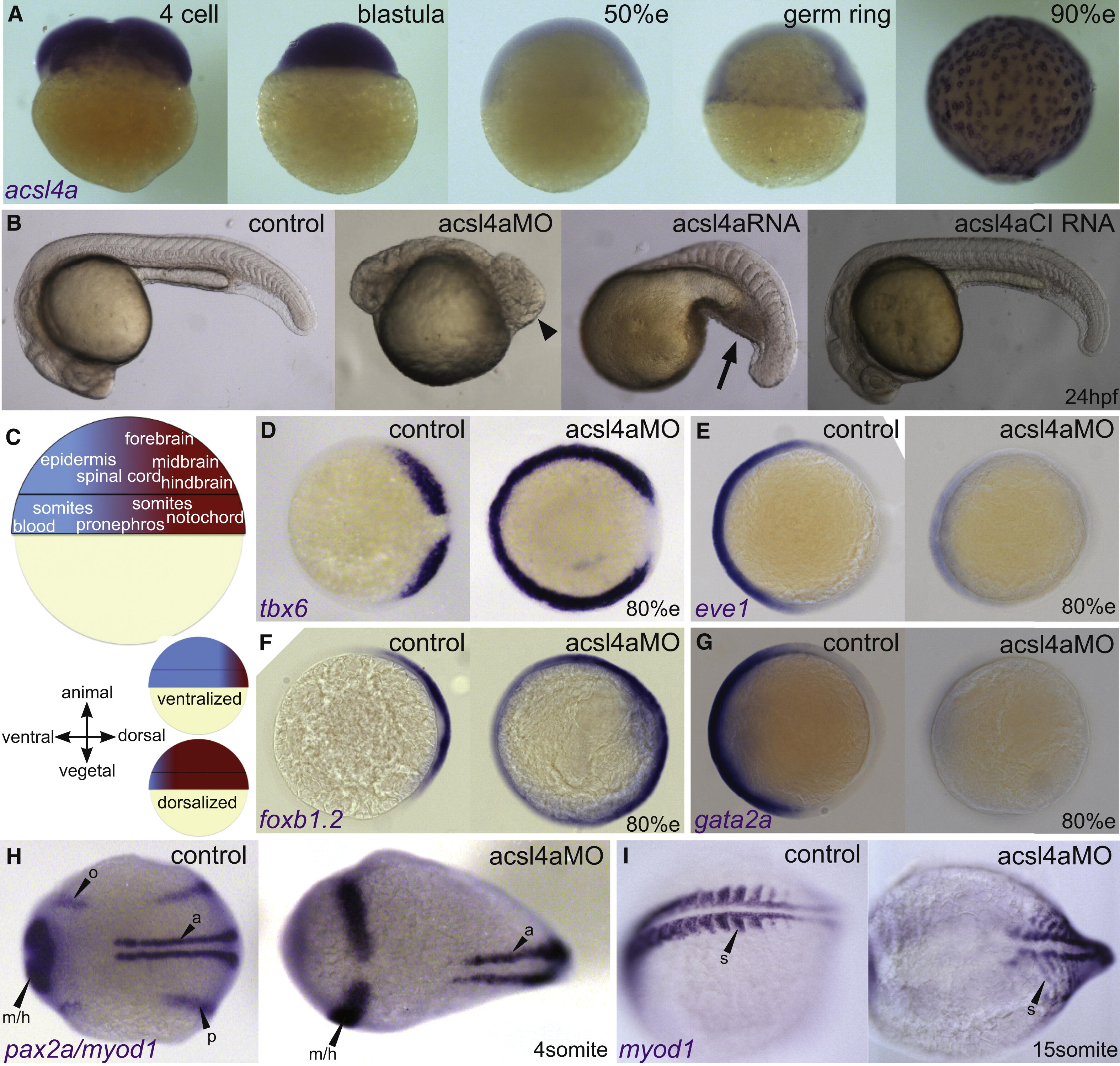Fig. 1
Fig. 1
(A) acsl4a expression throughout early embryonic development. Whole-mount mRNA in situ hybridizations. Expression pattern was consistent over multiple experiments (n = 7) and between two separate riboprobes targeting acsl4a. Lateral views, animal pole to the top. e, epiboly.
(B) Morphological defects in dorsoventral patterning caused by perturbation of acsl4a expression. Phenotypic classes were assigned as described elsewhere ( Kishimoto et al., 1997). Representative bright-field images of wild-type embryos (24 hpf) that are dorsalized (class C4 phenotype shown) when injected with acsl4a MO and ventralized (class V3 phenotype shown) when injected with acsl4a mRNA. Embryos injected with a catalytically inactive version of acsl4a (acsl4aCI) mRNA and control siblings develop normally. Arrowhead indicates wound-up trunk and arrow indicates expanded blood island. 500 fmol acsl4a MO; n = 8 experiments (406 embryos); 79%C5, 8%C4, 11%C3, 1%C2, and 1%C1; 1.2–1.5 ng acsl4a mRNA; n = 3 (101 embryos); 6%V4, 23%V3, 25%V2, 45%V1, 2%N; 1.2–1.5 ng acsl4aCI mRNA; n = 3 (123 embryos); 100% N.
(C) Fate map of the gastrula-stage zebrafish embryo (Kimmel et al., 1990 Schier and Talbot, 2005). Blue represents ventral fates and red represents dorsal fates.
(D–G) Whole-mount mRNA in situ hybridization of markers of dorsal and ventral tissues in 80% epiboly stage embryos, either control or acsl4a MO-injected. Animal pole view, dorsal to the right. (D) tbx6, a marker of dorsal presumptive paraxial mesoderm, is expanded ventrally in acsl4a MO-injected embryos. 95% of acsl4a MO-injected (750 fmol) embryos displayed expansion >180 degrees (n = 8; 323 embryos). (E) eve1, a marker of ventral mesoderm, is reduced in acsl4a MO-injected (500 fmol) embryos (97%; n = 6; 272 embryos). (F) foxb1.2, a marker of neural plate/dorsal ectoderm, is expanded ventrally in acsl4a MO-injected (500 fmol) embryos (93%; n = 4; 135 embryos). (G) gata2a, a marker for epidermis/ventral ectoderm, is reduced in acsl4a MO-injected (500 fmol) embryos (98%; n = 4; 181 embryos).
(H) pax2a and myod1 expression in four-somite stage embryos. Dorsal view, anterior to the left. pax2a marks m/h, midbrain/hindbrain boundary; o, otic placode; and p, pronephros. myod1 marks a, adaxial cells. 98% of acsl4a MO-injected (500 fmol) embryos had expansion of pax2a marking m/h (n = 7; 125 embryos). Seventy-five percent of acsl4a MO-injected (500 fmol) embryos had loss and 25% had reduced expression of pax2a marking pronephros (n = 5; 86 embryos).
(I) myod1 expression in 15-somite stage embryos. Dorsal view, anterior to the left. s, somites. Ninety-six percent of acsl4a MO-injected (500 fmol) embryos had expanded somites (n = 10; 138 embryos).
See also Figures S1 and S2.
Reprinted from Developmental Cell, 27(6), Miyares, R.L., Stein, C., Renisch, B., Anderson, J.L., Hammerschmidt, M., and Farber, S.A., Long-Chain Acyl-CoA Synthetase 4A Regulates Smad Activity and Dorsoventral Patterning in the Zebrafish Embryo, 635-647, Copyright (2013) with permission from Elsevier. Full text @ Dev. Cell

